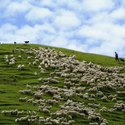Dairy research company DairyNZ set up the Greenfield research farm to investigate the possibility of using automatic milking systems on New Zealand dairy farms.
Setting up the farm involved three main phases. Each phase of the project addressed particular research problems. The solutions to these problems are being used to develop a system that can be used on commercial farms.
Phase 1: Establishment
The aim of phase 1 on the Greenfield farm was to find out if an automatic milking system (AMS) can be used on pasture-based farms. AMS was introduced from Europe, where farms use robots to milk cows more than twice a day. These farms use high-energy feed supplements, and cows produce a lot of milk. Using an AMS, these farms can milk their cows 3–4 times per day. Cows on New Zealand farms produce much less milk because their food (grass) has much less energy. Would AMS be worthwhile if the cows are milked less than twice a day?
Ten hectares of flat, fertile land were ring-fenced, and an adjacent one-way lane was put down from the dairy to the centre of the farm. A selection unit in the middle of the farm directed cows either to pasture (if they had been milked in the last 6 hours) or to the dairy for milking. Scientists did not know if the cows would walk themselves 400 m to be milked, as most overseas farms where an AMS had been used required them to walk only a very short distance inside a barn. Scientists were also unsure if the cows would be able to change their biorhythms to visit the dairy throughout the 24-hour period it was available and not just at the times when they were used to being milked.
At first, a small herd of only 10 cows was introduced to the farm. They quickly learned to use the AMS, and initial problems in the system were addressed.
Find out more about training cows to milk themselves.
Within months, the herd size was increased to 40. The cows visited the dairy throughout the day, with only one lull in activity between 2 am and 6 am when it seemed that the cows were resting or sleeping.
Phase 2: Scale-up step 1
Once the Greenfield Project had proved that AMS could work on a small scale, another 40 cows were added to the milking herd. More grass and more space were needed, so the farm size was increased to 23 hectares. More races and another selection unit were added.
This meant the distance the cows had to walk to be milked more than doubled (from a maximum of 400 m to a maximum of 900 m). Would they cope or would this result in cows not wanting to walk from their paddock to the dairy? Researchers found that the cows would walk the longer distances, and that this did not cause any increase in the incidence of footrot disease.
Another problem was getting the increased number of cows through the one automatic milking system. The minimum milking interval was increased from once every 6 hours to once every 12 hours. Despite being milked much less often, the amount of milk produced by each cow only slightly decreased.
Phase 3: Scale-up step 2
Once it had been shown that cows would walk further to be milked with no major problems and that they were almost equally productive when milked less often, the herd was increased to 180 cows. This made the herd size much closer to the average herd size on New Zealand dairy farms, proving the commercial viability of an AMS on New Zealand’s pasture-based farms. Twenty hectares were added, ring-fenced and raced. Another selection unit was needed, and scientists tried a new design of races to simplify the laneway system and get more land coverage from each selection unit. There were now too many cows for a single robotic milker (nicknamed Merlin), so a second Merlin was added to the dairy.
Related content
Check out the unit plan on robotic milking. Students use information about AMS to design the layout of their own farm. The unit plan also curates Hub robotic milking resources.
Dairy innovations – targeting climate change curates resources developed in collaboration with DairyNZ.
Useful links
Information about robotic milking systems from DairyNZ, covering everything from what to consider, to getting started and fine tuning.
History of the Greenfield project on the DairyNZ website.



